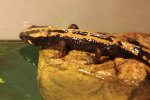firedreams
2010 Research Grant Donor
- Joined
- May 31, 2009
- Messages
- 243
- Reaction score
- 7
- Points
- 0
- Location
- Toronto, ON
- Country
- Canada
- Display Name
- Lydia
Hi all,
I recently purchased an adult CB Laotriton from a fellow newt enthusiast. I was told upon purchase that she(?) was a fickle eater, and that she had refused food on the day that I picked her up. I picked her up 1 week ago today, and she has not eaten under my care. 2 days ago she left the water and climbed up on her turtle shelf. I checked all of the water parameters and everything is fine (it is a planted tank with hides and a sponge filter on low). Today I took her out for a closer examination and noticed that she has sores on her body (see attached picture). I immediately removed her from the tank and gave her a 10 min salt bath, then put her in a paper towel quarantine tank and applied Silver Sulfadine (sp?) cream to the sores. Can anyone tell me if this is the right course of action, or provide suggestions?
L
I recently purchased an adult CB Laotriton from a fellow newt enthusiast. I was told upon purchase that she(?) was a fickle eater, and that she had refused food on the day that I picked her up. I picked her up 1 week ago today, and she has not eaten under my care. 2 days ago she left the water and climbed up on her turtle shelf. I checked all of the water parameters and everything is fine (it is a planted tank with hides and a sponge filter on low). Today I took her out for a closer examination and noticed that she has sores on her body (see attached picture). I immediately removed her from the tank and gave her a 10 min salt bath, then put her in a paper towel quarantine tank and applied Silver Sulfadine (sp?) cream to the sores. Can anyone tell me if this is the right course of action, or provide suggestions?
L

